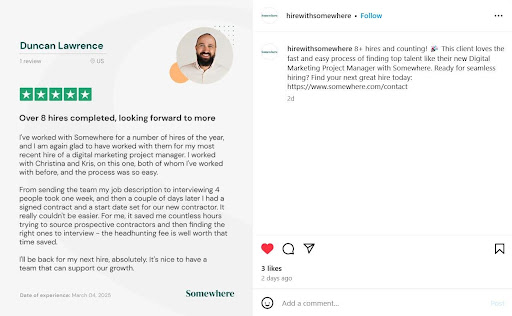You know social media isn’t just for memes and cat videos, right? For businesses, it’s one of the most powerful tools to demonstrate your expertise and build audience trust.
Here’s the important thing: Over 54% of users follow brands on Facebook and other social media networks to stay updated on products or services. That’s a huge opportunity.
But here’s the catch: just posting isn’t enough. You have to do it in a way that makes people see you as the go-to expert in your field. Luckily, this isn’t as hard as it seems. With the right approach, you can turn your social presence into a credibility-building machine.
To help you achieve that, we’ll break down five straightforward ways to use social media to demonstrate expertise and build trust. These are tactics that work whether you’re a solopreneur or part of a bigger team. Let’s get into it.
1. Show Your Product in Real-Life Situations
Social media users crave authenticity. Almost 27% of all internet users actively search for products to buy while scrolling through their feeds.
When they find your content, they want to see what your products actually look like in real-life situations, not just polished studio shots.
Real-world visuals build credibility because they show your product performing as promised. They also help potential customers visualize themselves using your product, which bridges the gap between browsing and buying.
Tips on Doing It Right
- Skip the overly edited glamour shots. Instead, post photos and short clips of your product in natural settings – being held, used, or even slightly worn in.
- Show different angles and close-ups so people know what they’re getting.
- Include captions that highlight practical benefits, not just features. For example, “These tires grip wet grass without slipping – perfect for rainy course days.”
- Encourage customers to share their own photos by reposting them (with credit). Nothing builds trust like real people vouching for you.
A Real Brand Doing It Right
A great example of this tactic is Golf Cart Tire Supply, a company that sells accessories for golf carts. Their social media accounts regularly feature golf carts with their products installed in everyday settings – on golf courses, in neighborhoods, at campgrounds, and on trails.


Their content shows their products performing in various terrains and weather conditions. Rather than just posting catalog-style images of tires and parts, they share videos of carts climbing hills, navigating rough terrain, or simply being used for daily transportation.
By helping customers see how the products perform in real-world applications, this approach will demonstrate expertise and build trust in your product.
So, ditch the sterile catalog look. When people see your product solving real problems, they’re more likely to believe in what you sell.
2. Share Expert Insights and Industry Knowledge
When you freely provide valuable information, you position your brand as an authority in your field. Research shows that consumers are more likely to buy from brands they see as helpful.
By sharing expertise rather than just selling products, you create trust and establish your brand as the go-to resource in your industry.
This works because it shifts the relationship from transactional to educational. When you help customers understand complex topics related to your industry, they’ll trust your products and services more. It also keeps your audience engaged between purchases and attracts followers who haven’t bought from you yet.
Tips on Doing It Right
- Share bite-sized expertise. Break down complex topics into simple tips, how-tos, or quick explainers.
- Stay ahead of trends. Post updates on industry changes, news, or new regulations before your competitors do.
- Answer common questions. Turn FAQs into short posts or reels. If people keep asking, it’s worth addressing publicly.
Use a mix of formats. Carousels for step-by-step guides, short videos for quick takeaways, and infographics for stats.
A Real Brand Doing It Right
RE Cost Seg is a great example here. They offer cost segregation services for real estate owners, which can easily come off as dry or overly technical. But their social media flips that.
Instead of simply promoting their services, they regularly share content explaining tax code changes, depreciation strategies, and investment tips relevant to property owners. Their posts break down complicated tax concepts into clear, actionable information that helps their audience make better financial decisions.
They also keep followers updated on industry trends, regulatory changes, and market developments that might impact real estate investments.


This strategy has helped them build trust with their audience before potential clients ever contact them for services, creating a warm lead pipeline of people who already value their expertise.
That’s exactly the kind of presence that builds credibility and keeps people coming back for more.
3. Let Your Happy Customers Do the Talking
Customer testimonials carry tremendous weight in building credibility. A striking 72% of customers say that positive reviews and testimonials directly impact how much they trust a company.
When potential customers see others praising your products or services, they’re more likely to believe in your expertise and value.
This approach works because people naturally trust their peers more than brand messaging. Authentic testimonials provide social proof that cuts through marketing skepticism. They show real results from real people, creating confidence that your brand delivers on its promises.
Tips on Doing It Right
- Keep it real. Use direct quotes, screenshots, or video clips of customers sharing their experiences in their own words. No editing or fluff.
- Highlight specific results. Testimonials that mention concrete outcomes (“Saved me ten hours a week!”) are more convincing than vague praise.
- Make it visual. Turn text reviews into eye-friendly graphics or short video snippets for higher engagement.
- Spread them out. Don’t dump all testimonials at once. Space them out between other content to keep social proof fresh.
A Real Brand Doing It Right
Somewhere, a platform for businesses to hire remote employees, executes this strategy effectively. Their social media profiles regularly feature images showing unedited screenshots of customer testimonials.
These testimonials appear exactly as written by their clients, preserving the authentic voice and enthusiasm of each business owner or manager. The screenshots show real feedback from companies that have successfully found quality remote talent through their platform.
Their approach emphasizes transparency by sharing the exact words their customers used rather than creating polished marketing copy. Many testimonials specifically mention how Somewhere helped solve staffing challenges or improved team productivity with remote workers.


This way, potential clients can see specific examples of how the platform has helped similar companies, making it easier to trust Somewhere with their own hiring needs.
So, don’t just tell people you’re great. Let your customers say it for you. Real praise beats self-promotion every time.
4. Teach People How to Use What They’ve Bought
When customers buy your products, they want to extract maximum value from their purchase. By creating content that helps them do just that, you strengthen your relationship with existing customers while simultaneously showcasing your expertise to potential buyers.
This approach works on multiple levels. First, it shows you care about customer success beyond the initial transaction. Second, it demonstrates your deep knowledge of your products and their applications. Finally, it creates ongoing engagement with your brand as customers return for guidance and inspiration.
Tips on Doing It Right
- Create tutorials, not ads. Film step-by-step guides showing your products in action. Keep the focus on education, not promotion.
- Solve common frustrations. Address FAQs or pain points (for example, “What to feed my aquarium angelfish in the morning?”) to save customers time and hassle.
- Use real scenarios. Demonstrate your products in projects people actually care about, like holiday crafts or quick repairs.
- Keep it accessible. Break down complex tasks into simple, skimmable steps (bullet points in captions or timestamps in videos).
A Real Brand Doing It Right
Sewing Parts Online, a sewing machines accessories company, exemplifies this approach perfectly. Their YouTube channel serves as an educational hub for sewing enthusiasts of all skill levels.
Their content includes comprehensive tutorials on projects like creating a Christmas stocking from scratch, troubleshooting common sewing machine issues, and mastering specific techniques. Each video naturally incorporates products they sell without feeling like a sales pitch.
The tutorials are genuinely helpful, focusing on teaching valuable skills rather than pushing products. When they demonstrate using a particular sewing foot or machine feature, they explain the benefits clearly while showing the item in actual use.


This approach has built a loyal community around their brand. Customers trust their expertise and return to their channel when starting new projects or facing challenges. For potential customers, these tutorials provide proof of the company’s knowledge and commitment to customer success.
The more you empower your buyers, the more they’ll trust (and return to) your brand. Help them win, and they’ll remember who made it possible.
5. Put Your Team’s Expertise Front and Center
Putting real faces and credentials behind your brand humanizes your company while establishing authority.
When customers see the qualified professionals who are working for you, they gain confidence in your ability to deliver quality products or services.
This strategy builds trust because it proves you have knowledgeable people solving problems and creating solutions. It transforms your brand from an abstract entity into a team of qualified experts. This transparency helps customers feel comfortable entrusting their needs to your company.
Tips How To Demonstrate Expertise And Build Trust
- Highlight credentials. Share employee bios that emphasize relevant experience, certifications, or industry achievements.
- Showcase roles. Explain what each team member does and how they contribute to customer success.
- Use professional but approachable visuals. A mix of headshots and candid work photos humanizes your brand.
- Spotlight behind-the-scenes moments. Brief clips or posts of your team in action (for example, solving problems, training, or collaborating) add authenticity.
Final Thoughts
Expertise doesn’t speak for itself. It shows up in how you communicate, teach, and connect.
Social media gives you the space to do all of that, but it only works if you use it with intention.
Start implementing these strategies today, even if it’s just one tactic per week. Your audience will notice the difference, and so will your bottom line. And you will feel the increase









